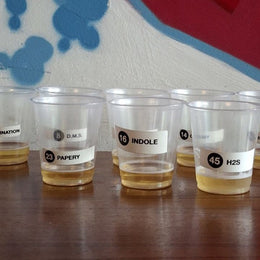
The steps we are going to cover are:
1. Agave cultivation
2. Harvest
3. Hydrolysis (cooking) 4. Extraction
5. Fermentation
6. Distillation
7. Blanco tequila
8. Aged tequila

1. Agave Cultivation
Let’s start with the main ingredient. Tequila can only be made of one key ingredient - the blue agave or agave tequilana Weber. So if the label doesn’t specifically say it’s blue agave, don’t worry it can still only be made of blue agave or agave azul. There are over 200 different agave species in the world and you can find around 150 of them in Mexico. Why did the tequila industry pick the agave azul from all those species? Well with its 5-6 years of growing period, it takes less time to grow these agaves - some other agave plants grow for over 15 years.


2. The Harvest
Once the agave is matured, it is harvested by the jimador.
They bring their sharp, shovel shaped equipment (the coa) to efficiently cut the leaves of the agave leaving only the middle ball part which is commonly referred to as piña but the bola or cabeza terms are often used too.

3. Cooking
Then the agaves are put on a truck that brings the piñas to the distillery where the cooking process begins to create fermentable sugars in the agave plant.
Producers can use brick ovens which is the old-school way to cook the agaves or autoclaves which is a modern machinery where extra pressure can be applied to reduce the cooking time.

4. Milling/ Extraction
After the agaves are cooked, the sugar rich agave juice is extracted.
The old-school method that only a handful of producers apply is the tahona. A heavy stone wheel goes around in a pit pressing the agave fibres to extract the agave juice.
The more common method is to use the roller mill. The roller mill utilizes mechanical presses and the fibres are delivered by a conveyor belt to each press. After only 4 pressings, the fibres are discarded making it a lot faster and more efficient than the tahona.

5. Fermentation
The next step is the fermentation. Now, this is where the fun begins as the sugars in the agave juice convert to alcohol.
The fermentation process is about the yeast converting the sugar into alcohol and Carbodioxid. In fact we enjoy the poo of another animal so much.
At the end of the fermentation, basically we get a ‘beer’ of 4-5% abv (8-10 proof) that producer’s distill to reach a higher level of alcohol.

6. Distillation
Distillation takes advantage of the different boiling points of the water and alcohol. Water boils at 100C (212F) and Alcohol which refers to ethanol has a boiling point of 78.37C (173.1F).
When producers start to increase the temperature, the alcohol evaporate at a quicker rate and can be separated and concentrated. By using different distillation techniques, producers can increase the alcohol level from 4-5% (8-10 proof) from the fermentation to 55-70% (110-140 proof) and then they add water to dilute it back to the desired level which is usually around 40% (80 proof).

7. Blanco Tequila
Right after distillation, the tequila can be bottled as a blanco tequila or it can be aged.
8. Maturation/Aging
Only aging in oak containers count for aging purposes and the classification changes based on the amount of time tequila spends in oak as covered in the classification section. Producers may use oak vats for aging blanco and reposado tequilas and oak barrels with a maximum of 600L capacity to age añejos and extra añejos.
This feature is brought to you by Tequila Stop and the International Tequila Academy.
Tequila Stop aims to share is love for Mexico and its beloved Spirit with fans in Asia Pacific, bringing fans the best that Tequila has to offer, through an extensive catalogue of premium Tequilas and Mezcals straight from the source. Tequila Stop works closely with Mezcaleros across Mexico, and is also partners with the International Tequila Academy.








